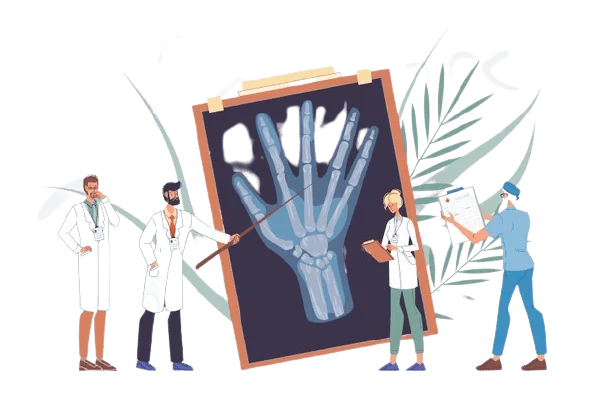Arthritis pain treatment online | Online Physiotherapy Clinic
- Affordable and reliable treatment for Arthritis pain
- Video sessions with expert Physiotherapists/ PTs.
- Specialized physical therapy for Arthritis pain, sprain, bursitis, or stiffness
Begin Therapy
Consult online with best Physios
A New Model for Arthritis Pain Treatment
We understand that it’s difficult for most of us to find time for traditional Arthritis physical therapy. PhysioMantra brings to you online Arthritis pain treatment, where all Arthritis exercises and treatments are managed through regular online check-ins & video sessions.
Expert Physical therapists
Mantra Care members get matched with a professional physiotherapist for one-on-one Arthritis pain treatment. They use interactive exercise videos available on our app to treat you.
Continuous Medical Care
Mantra Care physiotherapists are 100% virtual and provide physical therapy to patients without any time and geographical barriers. Our technology-enabled approach helps manage physical ailments from head to toe.
Personalized Arthritis Pain therapy
MantraCare provides everyday exercises, home remedies, and regular check-ins for all your Arthritis pain physiotherapy needs. We individualize treatment for each person, with problems including Arthritis pain, muscle injuries, sprain, bursitis, stiffness, and more.

Best Arthritis Pain Clinic, Now In Your Pocket
Our physical therapists or PTs are available in all parts of the world via an easy-to-use mobile application. The use of artificial intelligence, and data science enables the patients to connect with expert physiotherapists and get real-time insights into their Arthritis health. Download PhysioMantra App Now.

How it works

Signup for our Arthritis Treatment Program
Just fill up a 5-minute online form to tell us about your Arthritis pain history and treatment expectations.

Meet your PT
We will connect you with a physiotherapist who is available 24/7 to you via call or chat.

Connect to our app
Get Physical Therapy sessions on our app via video calls. Follow exercises suggested by our PT and track your progress in the app.
Meet the best online physical therapist
MantraCare physical therapists treat muscle and joint pain problems through a combination of body exercises, video demonstrations, and a healthy diet. Our treatment experience is a better traditional in-person approach in multiple ways.

Dedicated Physio
You get a personal Physio who customizes the exercise plan based on your comfort and needs

App-guided Exercises
3D animations & voice narrations in our app ensure proper and right guidance

Expert care anywhere, anytime
With over 200+ physios, MantraCare is 100% online – no waiting rooms

Exercise Kit
Complete exercise kit with elastic bands, door anchor, and a phone stand – mailed to you
A Complete Guide On Arthritis Pain Physiotherapy
Understanding Arthritis Pain
Arthritis is a condition in which one or more of your joints enlarge and become tender. Joint pain and stiffness are the most common symptoms of arthritis, which usually increase with age. Osteoarthritis and rheumatoid arthritis are the two most prevalent forms of arthritis.
Cartilage — the firm, slippery tissue that covers the ends of bones where they form a joint — breaks away as a result of osteoarthritis. Rheumatoid arthritis is a condition in which the body’s immune system assaults the joints, starting with the joint lining.
Gout is caused by uric acid crystals that develop when there is too much uric acid in your blood. Other kinds of arthritis can be caused by infections or underlying illnesses like psoriasis or lupus.
Symptoms of Arthritis Pain
The following are some of the signs and symptoms of rheumatoid arthritis:
- Joints that are painful, heated, and swollen
- Morning stiffness and inactivity are the most common causes of joint stiffness.
- Fever, fatigue, and a lack of appetite
- Smaller joints, such as the joints that connect your fingers to your hands and your toes to your feet, are often the first to be affected by early rheumatoid arthritis.
Wrists, knees, ankles, elbows, hips, and shoulders are frequently affected as the illness develops. Symptoms appear in the same joints on both sides of your body in the majority of instances.
Causes of Arthritis Pain
The two main types of arthritis — osteoarthritis and rheumatoid arthritis — damage joints in different ways.
Osteoarthritis
Osteoarthritis, the most prevalent type of arthritis, is caused by wear and tear on your joint’s cartilage, which is the hard, smooth covering on the ends of bones where they form a joint. Cartilage cushions the ends of the bones and allows for virtually frictionless joint mobility, but enough damage can result in bone grinding directly against bone, causing discomfort and limiting movement. Wear and strain can build up over time or be accelerated by a joint injury or illness. The entire joint is affected by osteoarthritis. It leads to alterations in the bones as well as degeneration of the connective tissues that hold the joint together. Inflammation of the joint lining is also a side effect.
Rheumatoid arthritis
The immune system assaults the lining of the joint capsule, a thick membrane that encloses all the joint components, in rheumatoid arthritis. This lining (synovial membrane) swells and becomes irritated. Within the joint, the disease process might eventually damage cartilage and bone.
Treatment of Arthritis Pain
The goal of arthritis therapy is to alleviate symptoms and improve joint function. Before you figure out what works best for you, you may need to try a few different therapies or combinations of treatments.
Medications: The medications used to treat arthritis vary depending on the type of arthritis. Commonly used arthritis medications include:
- Painkillers. These drugs aid with pain relief but have no impact on inflammation. Acetaminophen is an over-the-counter alternative (Tylenol, others).
- Nonsteroidal anti-inflammatory medicines (NSAIDs): These are medications that are used to treat inflammation (NSAIDs). Both pain and inflammation are reduced with NSAIDs. Ibuprofen (Advil, Motrin IB, and others) and naproxen are two over-the-counter NSAIDs (Aleve). Some NSAIDs are only accessible with a prescription.
- Counterirritants. Menthol or capsaicin, the chemical that makes hot peppers fiery, is found in certain lotions and ointments. Rubbing these treatments on the skin over your painful joint may cause pain signals from the joint to be disrupted.
Therapy: Some forms of arthritis may benefit from physical therapy. Exercises can help you increase your range of motion and strengthen the muscles that support your joints. Splints or braces may be necessary for some instances.
Surgery: If conservative methods fail to alleviate your symptoms, your doctor may recommend surgery, such as joint repair. Joint surfaces can be polished or repositioned to decrease discomfort and enhance function in some cases. These treatments are frequently performed arthroscopically, which means they are done through tiny incisions over the joint.
- Joint replacement is a procedure that involves replacing a joint. Your injured joint is removed and replaced with an artificial one during this operation. Hips and knees are the most often replaced joints.
- Fusion of the joints. Smaller joints, such as those in the wrist, ankle, and fingers, are more commonly treated with this treatment. It separates the ends of the two bones of the joint and then locks them together until the joint heal into a single stiff unit.
Physiotherapy of Arthritis Pain
For most patients with arthritis, physiotherapy is a crucial element of their treatment. It is directed by physiotherapists who are part of a team of healthcare experts who assist you in resuming or maintaining an active and independent life at home and at work. They know how to analyze movement and can teach you how to protect your joints. Your physiotherapist will:
- provide you with advice and reassurance
- make you feel confident in your ability to manage your condition
- Set suitable goals to keep you as active as possible by addressing any fears or uncertainty
Physiotherapists are experts at identifying and treating joint and muscle issues. Your GP may refer you to a specialist physiotherapist rather than to a rheumatologist or orthopedic surgeon.
Forms of Physiotherapy of Arthritis Pain
The most common sort of physiotherapy include:
- Passive Physical Therapy: This sort of physiotherapy includes heat application, usage of ice packs, and electrical stimulation. for instance, a hot pad is often wont to warm up the muscles and make them more flexible for the exercises.
- Active Physical Therapy: Active physiotherapy is more about exercising and stretching muscles in order that they open up, relieving the pain as a consequence. Once we avail of Physiotherapy services for Arthritis pain, we can get rid of all the pain, and also we can prevent it from coming back after some interval of time.
Benefits of Physiotherapy of Arthritis Pain
Physical therapists can help treat elbow injuries, and physical therapy for elbow pain is intended to offer three important benefits.
- Reducing pain
Physical therapy for elbow discomfort focuses on one thing: decreasing pain. Tennis elbow and golfer’s elbow are common sports ailments that cause elbow discomfort. The tendons on the outside and inside of the elbow are both damaged in these situations.
- Improving range of motion
Reduced range of motion in the elbow is another issue that physical therapy for elbow discomfort may assist with. The amount you can move a joint depends on its range of motion, which can be severely limited by elbow problems. Tennis or golfer’s elbow can cause forearm muscle weakening or limitation, which is important for elbow joint mobility.
- Decreasing risk of future injury
Physical treatment for elbow discomfort might also help you avoid re-injuring your elbow. Physical therapists can assess how you move your elbow when playing tennis or golf to achieve this. This allows them to identify any posture abnormalities that may put you at risk for future accidents. Your therapist can help you fix movement difficulties after they’ve been identified, and better playing motions and posture can help reduce the chances of re-injuring your elbow in the future.
10,000+ Happy Arthritis Pain patients from the world

“Straight after the initial stages of the treatment when my husband was able to reproduce my headache pain just by mobilizing my neck, I knew that my long and desperate journey had finally reached the place of genuine help. There is nothing like Mantra Care in Nigeria.”
Kamya, 3 Months at MantraCare
Best physiotherapist from across the world





We treat nearly all muscle and joint issues
Not all physical or muscle problems are the same. Different types of problems require different treatments. At MantraCare, 200+ physical therapist the world cover a range of specialties to meet your needs be it back pain, shoulder pain, or sports injury:
Frequently Ask Questions
You don’t have to worry about attending a clinic or hospital and aggravating your ailment now that internet physiotherapists are available. Simply Google “Arthritis physiotherapy near me” and use Mantra Care to schedule an appointment with a physiotherapist. You’ll get access to the best-trained physiotherapists to help you reclaim your regular life as quickly as possible.
People hold the misconception that physiotherapists exclusively diagnose and treat through hand-on-hand treatment. Physiotherapists, on the other hand, do study your illness and lifestyle, as well as asking you questions to determine your therapy options.
Your PT will ask you a series of focused questions during a video consultation on MantraCare to evaluate if your symptoms indicate Arthritis discomfort. Then your doctor will devise the simplest and most straightforward treatment strategy for you. If necessary, your physician may suggest an in-person evaluation by a specialist. The duration and severity of your symptoms, as well as your medical history, will determine your treatment approach.
Your doctor will re-evaluate the risks and advantages of the various treatment options after a diagnosis has been established. Treatment for Arthritis discomfort varies depending on the severity of the condition.
The sort of treatment to be utilized is determined by a number of criteria, including the severity of the case, the duration of the full session to be attended, and the type of physiotherapy that the patient requires.
When compared to traditional in-person physiotherapy, online physiotherapy is a very effective and low-cost option. When compared to the costs charged at hospitals and clinics, internet physiotherapy is 20-40% less expensive.
For most patients with arthritis, physiotherapy is a crucial element of their treatment. It is managed by physiotherapists who are part of a team of healthcare experts that assist you in resuming or maintaining an active and independent life at home and at work.
Physiotherapists can help you with exercise, pain treatment, and other strategies to manage your disease. They can show you how to strengthen your muscles while also improving your joint movement and walking.
- Maintain healthy body weight.
- Maintain a healthy blood sugar level
- Exercise is important.
- Extend yourself
- Avoid being hurt.
- Smoking should be avoided at all costs.
- Eat fish at least twice a week.
- Preventive care should be done on a regular basis.
Remember to talk to your doctor before trying any remedy for arthritis, whether it involves medication or not.
- Manage your weight.
- Get enough exercise.
- Use hot and cold therapy.
- Try acupuncture.
- Use meditation to cope with pain.
- Follow a healthy diet.
- Add turmeric to dishes.
- Get a massage.










